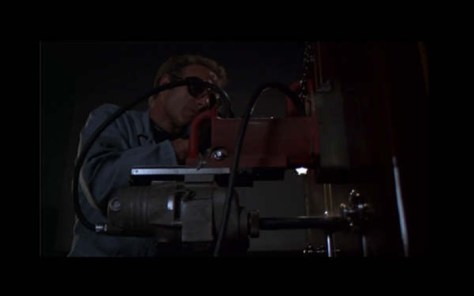
Deep in space, a derelict rocket from the year 1987 – centuries in the past – explodes into splinters of radioactive dust, destroyed by its own nuclear weapons. The pulsing electronic noise that had built-up towards the detonation abruptly stops, and for the first time in a long while we are left with total silence. Back on board the Ikarie, the modern spaceship that discovered this old ruin lost millions of miles from Earth, we see the stunned faces of the crew. In one cabin, two astronauts discuss the crimes of the twentieth century, its wars and its holocausts. One of them begins absentmindedly picking out a few chords on a grand piano, which has a peculiar wing-like double lid. ‘Honegger,’ he says, by way of explanation. ‘Also twentieth century.’
Those piano chords are from the introduction to Arthur Honegger’s dramatic psalm, ‘Le roi David’, from 1921. Composed by one of ‘Les Six’, the group of dynamic young composers who gathered around Jean Cocteau and Erik Satie, in its day ‘Le roi David’ was strikingly modern in its wild eclecticism, borrowing freely from jazz and gregorian chant, Bach and Stravinsky. But for all its lyrical beauty, amid the future sounds of Zdenĕk Liška’s score for Ikarie XB-1 (1963), directed by Jindrich Polák, it sounds positively antediluvian, like the dim ghost of a distant age.
Born in the small Bohemian town of Smečno just short of a year after ‘Le roi David’ was first performed, Liška would work on many of the classics of the Czech new wave (Vĕra Chytilová’s Fruit of Paradise, Kădar and Klos’s The Shop on Main Street, Juraj Herz’s The Cremator) before embarking on a long and fruitful collaboration with Jan Švankmajer. When, after a long illness, Liška died in 1983, Švankmajer refused to work with any other composer and for a long time used only classical music in his films.
For Ikarie XB-1, he sets out his stall early, and the opening title music is little short of stunning. With a jerky melodic motif resembling one of Conlon Nancarrow’s player piano studies or a John Cage prepared piano sonata, albeit reconfigured for a bank of haywire oscillators, the piece mixes orchestral and electronic tones until they become almost completely indistinguishable. Turning usual practice on its head, it’s the live instruments that here produce the sound effects, while the electronics carry the tune.
This high pitch of strangeness is maintained throughout. The score ranges from dreamy impressionism to tense late romanticism, eerie drones to furious machine rhythms, and in one particularly odd scene in which the spaceship crew have their own dance party, even a sort of dissonant future mambo. With so many different moods and styles, it’s a soundtrack that was as modern and eclectic in 1963 as Honegger’s ‘Le roi David’ was in 1921. A heady stew of robot rhythms and whooshing frequencies, Ikarie XB-1 could be the missing sonic link between Forbidden Planet and Liquid Sky.
Robert Barry









